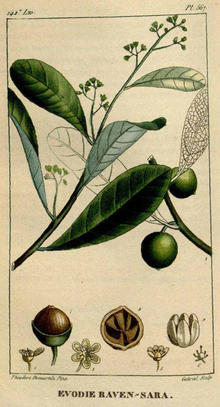Ravensara
| Ravensara | |
|---|---|
 |
|
| Scientific classification | |
| Kingdom: | Plantae |
| (unranked): | Angiosperms |
| (unranked): | Magnoliids |
| Order: | Laurales |
| Family: | Lauraceae |
| Genus: | Ravensara |
| Species | |
|
See text. |
|
See text.
Ravensara is a genus of trees and shrubs belonging to the family Lauraceae and endemic to the island of Madagascar (Central and Eastern regions) and the Comoro Islands. The bark, leaves and fruit of the various species are rich in aromatic essential oils. In a recent generic classification of Lauraceae based on DNA sequence data by Chanderbali et al. in 2001, it was found to be part of a strongly supported clade that also includes Beilschmiedia, Potameia, , Endiandra and Aspidostemon.
The best-known species is Ravensara aromatica, the essential oil extracted from the leaves of which is used in medicine Citation Nedeed. In Madagascar the common name in the Malagasy language applied to trees of this genus is Hazomanitra - 'tree that smells', while that of the bark of Ravensara anisata is Havozo. Ravensara is a genus of evergreens in the plant family Lauraceae that currently includes around 30 species, mostly in laurel forest habitat. The genus Ravensara, endemic to Madagascar, was described by Sonnerat in 1782 with the single species Ravensara aromatica. Kostermans maintained Ravensara in his treatment of the Lauraceae for the "Flore de Madagascar et des Comores" and in a later publication from 1958 in which he described a further nine new species. Ravensara has always been considered closely related to . While the Madagascan species placed in Ravensara and Cryptocarya are still poorly known, the subsuming of Ravensara in Cryptocarya is not justified by the results of the DNA studies undertaken thus far. Furthermore the fruits of Ravensara spp. are of ruminate form, while those of the Madagascan species of Cryptocarya are not.
The genus includes species of evergreen trees, endemic to Madagascar and Comoro Islands. Ravensara species are broad-leaved evergreens, the genus including not only shrubs, but also large trees reaching heights in excess of 30 m at maturity. They are found commonly both as canopy trees to 30m (sometimes very large to 60 m) and sub-canopy trees in the succession climax species in tropical, lower temperate or subtropical broad-leaved forest. Habitats include evergreen broadleaved forest, mixed coniferous-broadleaved forest, low-elevation evergreen forest and littoral rainforest and feature soils of all types.
...
Wikipedia
